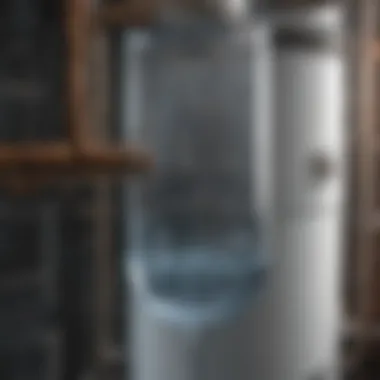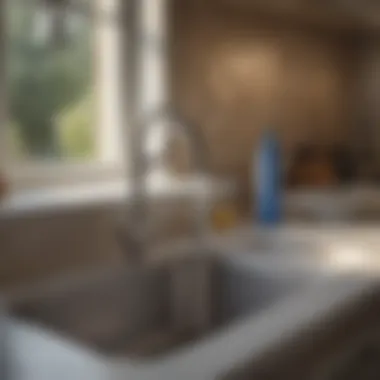Exploring the Benefits of Inline Water Filtration Systems


Intro
Inline water filtration systems are steadily gaining popularity, providing a sleek solution to improve water quality in homes. This article will guide homeowners and housewives through the ins and outs of these systems, highlighting their operational mechanics, advantages over traditional options, and what to consider when choosing one for your household.
As society becomes more aware of the importance of clean water, especially for health and daily routines, inline systems stand out with their simple yet effective technology. By examining the installation process, maintenance needs, and the positive impact on health and sustainability, readers will be better equipped to make informed decisions regarding their water resources.
Trending Styles
Modern Minimalism
The trend towards modernization has not left the realm of water filtration untouched. Inline water filters, with their compact designs and unobtrusive installation, fit perfectly into modern minimalist home aesthetics. These systems often blend seamlessly under the sink, taking up little space while ensuring that the water served is as pure as can be. The appeal lies not just in their functionality but also in the clarity they bring to contemporary living spaces, prioritizing both design and health.
Cozy Rustic
On the other side of the spectrum, the cozy rustic style draws homeowners looking for a touch of warmth and earthiness. Inline filtration systems can complement this ambiance too, especially models that embrace natural materials and muted colors. Think wooden cabinets and colorful ceramics paired with a reliable water filtration system that protects against contaminants, ensuring that that warm cup of herbal tea is as safe as it is soothing.
Practical Considerations
Integrating an inline water filtration system into your home involves understanding various aspects that cater to your individual needs. The choice largely depends on:
- Water source: Know where your water comes from. Municipal supplies often require different treatments compared to well water.
- Contaminants: Identifying specific impurities present in your water will guide your selection.
- Installation requirements: Can you do it yourself, or do you need a professional?
"Understanding the types of filtration systems available is crucial for ensuring you select the right one for your home's needs."
Health Implications
The health benefits of using inline filtration systems are substantial. These systems are designed to eliminate various pollutants from drinking water:
- Chlorine and chloramine: Often used in municipal water treatment, these can affect taste and smell.
- Heavy metals: Lead and arsenic contamination can be concerning, particularly in older plumbing systems.
- Bacteria and viruses: Some advanced systems offer protection against microbial threats.
By integrating such a system, households can foster an environment where everyone enjoys cleaner and safer water.
Epilogue
Prologue to Inline Water Filtration
As the world becomes more aware of the importance of clean drinking water, the demand for effective filtration systems is on the rise. Inline water filtration systems provide a solution, ensuring that the water from your tap is not only safe but also free from unpleasant tastes and odors.
These systems integrate directly into your existing plumbing, filtering water on-the-go, which gives them a practical edge over traditional methods that often take up valuable space or require significant setup.
Defining Inline Water Filtration
Inline water filtration systems work as part of your home’s plumbing, filtering water as it flows through the pipes. When you turn on your tap, the water passes through a filtration unit that removes impurities, contaminants, and other unwanted particles before it reaches your glass. The beauty of inline systems lies in their simplicity and efficiency.
A key component of inline filtration is the use of filters which can vary significantly in their design and function. Some utilize activated carbon, while others rely on reverse osmosis or ultrafiltration methods. This approach makes it easy to tailor systems to meet specific needs, whether you are concerned about chlorine, lead, or sediment.
The Need for Effective Filtration
Understanding the need for effective water filtration cannot be overstated. Contaminated water can lead to numerous health issues, such as gastrointestinal infections or long-term effects from heavy metals.
- Health Concerns: Many homes receive water that contains a variety of pollutants, from pesticides to industrial waste. The long-term consumption of such water raises several health risks.
- Taste and Odor Improvement: You might notice that your water has an unpleasant taste or smell. An inline filter can dramatically improve the drinking experience by removing chlorine and other chemicals.
- Convenience: Having an inline system means you don't have to worry about refilling pitchers or replacing bottles of water. It’s always available at your tap, delivering purified water instantly.
"Access to clean water is a basic human right, and an inline filtration system helps ensure that right is fulfilled in the comfort of your home."
Inline filtration systems not only safeguard health, but they also promote a more sustainable lifestyle by reducing reliance on plastic bottles.
By highlighting these elements, this introduction sets the stage for a deeper exploration of the mechanisms, benefits, and maintenance of inline water filtration systems as we further delve into this essential topic.


Mechanisms of Inline Water Filtration
Understanding the mechanisms behind inline water filtration systems is essential for anyone looking to improve their home’s water quality. It’s one area where the simplicity of installation combines with technological intricacies to produce cleaner drinking water. By getting the hang of how these systems operate, you can make a more informed choice about your water filtration needs, ensuring that you not only protect your health but also enhance the taste and clarity of the water you consume.
How Inline Systems Operate
Inline water filtration systems operate by taking advantage of the water flow in plumbing systems. They are designed to be strategically installed directly into the water line, usually under the sink or in the basement. When water flows through these systems, it passes through various filter elements which effectively capture impurities. This process helps in reducing contaminants like chlorine, sediments, and even some heavy metals, significantly enhancing water quality. The cool part is that these filters can operate with the existing plumbing setup, so you don’t have to go knocking down walls or running new pipes.
In a nutshell, these systems work continuously. As long as water is flowing into the home, the filter is doing its job quietly in the background. This seamless operation is a significant plus, providing constant access to cleaner water without the need for additional space, unlike bulky filtration systems that often take up precious cupboard real estate.
Types of Filtration Technologies
There are various technologies employed in inline water filtration systems, and understanding them can help tailor your choice to your specific needs. Below, we break down some of the most common filtration methods used.
Activated Carbon Filtration
Activated carbon filtration is one of the oldest and most trusted methods. This technology works by employing a porous carbon material that attracts and captures chemical impurities, effectively improving the taste and odor of the water. The key characteristic that makes activated carbon popular is its ability to remove chlorine and other volatile organic compounds effectively. In a household context, this translates to better-tasting water and fewer unpleasant odors.
One unique feature of this method is its adaptability; it can be configured for standard faucet filters or integrated into full-line systems. While it certainly has its benefits, a downside is that it might not be as effective in removing hard minerals or certain pathogens, so it’s often best used in conjunction with other methods.
Reverse Osmosis
Reverse osmosis (RO) takes filtration up a level by using a semi-permeable membrane. Through this system, water is forced through the membrane which blocks larger molecules and contaminants, allowing only clean water to pass. This is where reverse osmosis shines—it’s highly effective in removing a variety of harmful substances, including lead, fluoride, and nitrates. Because of this broad-spectrum filtration capability, RO systems are favored for their extensive contaminant removal.
However, the unique aspect of reverse osmosis is its waste production; for every gallon of purified water, up to three gallons can be discarded, which some homeowners may find concerning from an environmental perspective. It’s essential to weigh the benefits against the waste generated when considering this system for your home.
Ultrafiltration
Ultrafiltration is like the middle ground between activated carbon and reverse osmosis. It utilizes a membrane that removes particles in the micrometer range, including pathogens like bacteria and some viruses, but allows dissolved salts and smaller molecules to pass through. This means that the water retains essential minerals while still being cleansed of harmful pathogens, making it an appealing option for those who might not want to completely strip the water of its natural content.
A key characteristic of ultrafiltration is its efficiency; it can handle larger volumes of water and requires less energy compared to reverse osmosis systems. However, it may not be quite as effective on certain chemicals and heavy metals, which means it could be a better fit as part of a multi-stage filtration approach rather than a standalone solution.
Understanding these mechanisms and technologies is absolutely vital in making an informed decision about your water filtration options.
"The quality of your water can have a profound impact on your health and lifestyle. Investing in the right filtration system is fundamental for a healthier home."
In the next section, we will delve into the various benefits of inline water filtration systems, highlighting not just the health advantages but also the convenience and efficiency they bring to everyday life.
Benefits of Inline Water Filtration
When it comes to ensuring that families have access to clean and safe drinking water, inline water filtration systems offer distinct advantages. These advantages serve not only to improve the overall quality of the water we consume but also extend to functionality and sustainability in our homes. As homeowners and housewives consider their options, understanding the benefits of inline water filtration can pave the way for informed choices that enhance daily life.
Enhanced Water Quality
In the world of water filtration, the primary goal is undoubtedly to enhance water quality. Inline water filtration systems excel at this by using multiple techniques to reduce contaminants. Contaminants can range from harmful bacteria to heavy metals like lead, and they can enter our homes through various sources, including old plumbing. By employing technologies such as activated carbon and reverse osmosis, these systems can significantly reduce specific contaminants.
For example, activated carbon filters work like a sponge, soaking up impurities while allowing clean water to pass through. This process not only improves taste but also protects your family's health by ensuring that the water you drink is free from toxic substances.
"To drink clean water is to nourish the body and mind, ensuring that every sip contributes to overall wellness."
Convenience and Space-Saving
Today's homes often come equipped with limited space, making convenience a standout attribute of inline filtration systems. Unlike traditional pitcher filters or bulky countertop setups, inline systems are installed directly into your existing plumbing, frequently under the sink or even at the point of use. This means they can filter water as it flows through the pipes without taking up valuable counter space.
For many families, this aspect is a game changer. Imagine not having to refill pitchers or replace clunky filters regularly; with inline systems, clean water flows instantly from your tap. A simple twist and turn of the faucet provide you with the assurance of quality without compromising kitchen aesthetics.
Long-Term Cost Efficiency
While the initial investment in an inline water filtration system might seem steep, it's worth considering the long-term cost benefits. In many cases, homeowners realize substantial savings over time as the need for bottled water diminishes and filter replacements happen far less frequently.


When you weigh the average cost of shopping for bottled water against the costs associated with maintaining an inline system, the latter often emerges as a clear winner. Moreover, reducing reliance on plastic bottled water translates into environmentally-friendly practices. Not only is your drinking water cleaner, but your wallet benefits, and thus aligns well with a sustainable lifestyle, which more households are striving to achieve.
Installation Considerations
When it comes to installing inline water filtration systems, there is a range of factors that must be taken into account. The integrity and efficiency of the filtration process is heavily influenced by proper installation. Neglecting this stage can lead to undesirable consequences, such as reduced filtration efficacy or even costly repairs. This section will explore the key elements involved in the installation process, ensuring homeowners can navigate it with confidence and clarity.
Choosing the Right Location
Selecting the proper location for your inline water filtration system is crucial. Ideally, you want to place the system close to the main water supply line to minimize pressure loss and prevent unnecessary water waste.
A good location also makes filter access easier for replacements or maintenance. Here are a few considerations to make:
- Accessibility: Ensure the spot allows easy reach without major renovations.
- Avoiding Heat Sources: Keep the system away from areas that experience extreme heat.
- Space: Assess if the area has enough room for the filtration unit and any additional storage for replacement filters.
In short, choosing the right location is about balancing convenience and functionality.
Plumbing Requirements
Before diving into installation, being aware of plumbing requirements is a must. This type of filtration system often demands a bit more than standard tap setups. Here are several plumbing considerations:
- Pipe Compatibility: Check the size and material of your existing pipes.
- Water Pressure: Inline systems typically operate well within specific pressure ranges.
- Valves: Installing shut-off valves can come in handy for maintenance without having to drain the entire system.
"Proper plumbing is the backbone of any excellent water filtration setup."
Remember, handling plumbing issues might require some level of expertise, so assessing your own skills against your needs is wise.
DIY vs. Professional Installation
Choosing whether to tackle installation yourself or hire a professional can be a fork in the road. Each approach has its pros and cons:
- DIY Installation:
- Professional Installation:
- Cost-effective: Save that labor cost.
- Satisfaction: There's no feeling like doing it yourself.
- Learning Experience: You'll know your system intimately and how to maintain it.
- Expertise: Pros bring knowledge that can prevent installation errors.
- Time-saving: Hiring someone can free up your schedule.
- Warranty Considerations: Some manufacturers will require professional installation for warranty coverage.
Ultimately, weighing convenience against your comfort level with installation can guide your decision. If your plumbing skills are as rusty as an old pipe, it might be better to hire a professional.
In a nutshell, understanding these installation considerations can set the stage for a successful inline water filtration setup. When approached thoughtfully, this helps to ensure homeowners enjoy clean, safe water with minimal hassle.
Maintenance of Inline Water Filtration Systems
Ensuring the longevity and optimal performance of inline water filtration systems hinges on effective maintenance. Homeowners may not realize that the key to a steady supply of clean drinking water lies in regular upkeep. An unmaintained system can lead to decreased water quality, and can also result in higher replacement costs down the road. Therefore, understanding and implementing a proper maintenance routine is crucial for both health and financial savings.
Regular Inspection Protocols
Regular inspections are not mere checkboxes on a to-do list; they represent a proactive approach to water quality. These inspections can be straightforward and don’t require an expert’s touch for many components. Start by checking the filtration system's components visually for any obvious issues, such as leaks or cracks, as well as monitoring water pressure.
Some key protocols include:
- Visual Checks: Look out for any discoloration or unusual build-up on the filter.
- Functional Tests: Run water through the system and observe if flow rates seem unusually slow.
- Manometer Readings: If your system incorporates this gauge, it can indicate clogs in the filter that require attention.
- Documentation: Keep a log of inspections and findings. This can guide future maintenance and help track any recurring problems.
While it might feel tedious, consider these routines as one would for a vehicle; small checks prevent larger problems.
"Routine maintenance pays off in more ways than one; peace of mind comes standard!"
Filter Replacement Guidelines
Filter replacement doesn’t have to be an abstract notion. Instead, it should be as tangible as knowing when to change tires on a vehicle. Understanding when and how often to replace filters can greatly enhance the efficiency of inline water filtration systems.


Here are some useful general guidelines for replacement:
- Manufacturer Recommendations: Each inline system comes with a manual that usually suggests a timeline for filter changes. Adhering to these guidelines is essential for optimal performance.
- Usage Levels: Heavy use means filters will clog quicker. If your household uses significant water daily, you may need to replace filters sooner than the manual recommends.
- Indicators: Many modern systems come equipped with a change indicator. Take note of these as they serve as a handy reminder.
- Water Test Results: Regularly testing your water can reveal increased contaminant levels, indicating a filter change might be overdue.
In sum, a consistent filter replacement schedule not only ensures cleaner water but also helps to prolong the life of your entire inline system. Homeowners often find that a little diligence now saves a heap of trouble later.
Health and Environmental Impacts
Understanding the health and environmental impacts of inline water filtration systems is crucial for homeowners seeking to improve their water quality and contribute to a more sustainable lifestyle. This section will explore how these systems enhance health through contaminant reduction and promote eco-friendly practices.
Contaminant Reduction Capabilities
One of the primary roles of inline water filtration systems is to effectively reduce contaminants present in tap water. This can include anything from chlorine and heavy metals to bacteria and microplastics. Homeowners should be aware that the quality of tap water can greatly vary depending on geographical location and municipal standards.
- Chlorine: Often used in municipal water to disinfect, it can alter taste and odor. Inline filters utilizing activated carbon can significantly reduce chlorine levels, resulting in cleaner tasting and smelling water.
- Heavy Metals: Lead and other heavy metals, often found in older plumbing systems, pose health risks. Systems that employ reverse osmosis or ultra-filtration can drastically lower these contaminants, thus protecting occupants from potential health issues.
- Microorganisms: Pathogens such as bacteria and viruses can infiltrate drinking water, especially in areas with poor sanitation practices. Many inline systems now come equipped with ultraviolet (UV) light components that neutralize these harmful microorganisms.
By mitigating these harmful substances, inline filtration not only safeguards personal health but can also alleviate family members’ concerns about waterborne diseases, particularly for children and elderly individuals who might be more vulnerable.
"Clean water is fundamental to health — inline filtration systems help bring that directly to your home."
Contributing to Sustainable Practices
In addition to health benefits, inline water filtration systems play a significant role in contributing to sustainable environmental practices. By utilizing these filtration systems, homeowners can minimize their reliance on bottled water, which has broader implications for both waste reduction and carbon footprints.
- Reduction in Plastic Waste: Bottled water generates substantial plastic waste. By filtering tap water at home, families can cut down on their bottled water use and consequently reduce the amount of plastic ending up in landfills and oceans.
- Lower Energy Use: The production, transportation, and refrigeration of bottled water consume a significant amount of energy. Inline filtration systems do not only provide immediate access to clean water but also help in conserving energy in the long run.
- Encouraging Local Water Use: Utilizing filtered tap water encourages a connection to local water resources. It positively influences residents’ perception of their municipal supply as it becomes more palatable and trusted through filtration.
In summary, the health and environmental impacts of inline water filtration systems stretch far beyond the domestic sphere. They represent a pivotal element in creating healthier living conditions while contributing positively to global sustainability initiatives.
Evaluating Your Inline Water Filtration Options
Choosing the right inline water filtration system is akin to picking the right partner for a long-term commitment. You want to ensure it meets your specific needs without adding unnecessary complications. This section sheds light on evaluating your choices thoughtfully, helping you navigate the myriad options available on the market.
Identifying Specific Needs
Before you dive headfirst into the options, it’s essential to take a step back and assess your unique requirements. Not every household has the same water quality issues or needs, so a one-size-fits-all approach won't cut it. Here are some key considerations:
- Water Quality: Familiarize yourself with the specific contaminants present in your water supply. This information can typically be obtained from local water reports, or filtered through water testing kits available at stores. Identifying whether you need to filter sediment, chlorine, or heavy metals is crucial.
- Household Size and Usage: Consider how much water your family uses on average. A large family may require a system that can handle higher flow rates, while a smaller household might prioritize affordability and compact design.
- Installation Space: Space often plays a significant role in your options. Some inline systems require more space than others, especially those with additional features or larger filter sizes. Take a look at your plumbing layout to make this assessment.
Knowing these specifics will guide your search and help narrow down which systems are practical and beneficial for your setup.
Comparative Analysis of Brands and Models
Once your needs are crystal clear, it's time to wade through the available products. With so many brands and models, this might feel like an overwhelming maze. However, breaking down each option based on some critical factors can illuminate the pathway.
"Choosing well is an art; knowing the best requires knowledge."
- Filtration Performance: Look at each brand’s filtration capabilities. Ratings and reviews can speak volumes about how well a model can handle different types of contaminants. For instance, some may excel in removing chlorine but falter with heavy metals.
- Materials and Build Quality: The construction and materials used can significantly affect the longevity and efficiency of a filtration system. Pay attention to those built with durable and high-quality components to ensure they withstand regular usage over time.
- Cost Considerations: Of course, this is pivotal. Look at the upfront costs versus the ongoing filter replacement costs. Some models might seem affordable at first but may require pricey filters more frequently, tipping the scales in favor of initially pricier but more economical systems over time.
- User Experience: Feedback from other users is invaluable. Platforms like Reddit and Facebook often have community groups where real-life experiences are shared. This can give you insights that you won't find in standard product descriptions.
- Warranty and Support: Finally, consider the warranty offered by the brand and the quality of customer support. A brand that stands behind its product provides peace of mind, especially with something as crucial as water filtration.
By comparing each option based on these criteria, you’ll be well-equipped to select an inline water filtration system that not just fits but thrives within your home environment.
Culmination
As we wrap up our exploration of inline water filtration systems, it's essential to recognize the multifaceted importance of this topic. In today’s world, where water quality can vary dramatically based on sources and local infrastructure, having a reliable filtration system in place is more critical than ever. Inline water filtration systems provide not just convenience but also peace of mind, allowing homeowners to enjoy clean and safe drinking water directly from their taps without hassle.
Recap of Inline Water Filtration Benefits
To sum it up, inline water filtration comes with several notable benefits:
- Superior Water Quality: Unlike traditional methods, inline systems can effectively reduce contaminants such as chlorine, lead, and other impurities, delivering water that is not only safer but also tastes better.
- Space Efficiency: These systems are usually compact. This means they fit neatly under sinks or in tight spaces, leaving your counters clutter-free.
- Cost-Effective Over Time: While the upfront investment might seem significant, inline systems often prevent the need for buying bottled water, leading to significant savings down the line.
Inline systems are not just a temporary fix; they represent a long-term commitment to health and quality. Homeowners can ensure their families consume safe water daily, enhancing overall well-being.
Future Trends in Water Filtration
Looking ahead, the landscape of water filtration is poised for exciting changes. Here’s what we might expect:
- Smart Technology Integration: Imagine systems that not only filter water but also monitor its quality in real time, alerting users to any changes in water safety. This tech-driven approach could change how we interact with our household water.
- Sustainable Materials: The push for environmental responsibility is strong. Future inline systems are likely to rely on biodegradable materials and energy-efficient designs, minimizing their carbon footprint.
- Customization of Filters: As awareness about specific contaminants increases, future products might allow tailor-made filters catering to individual water quality needs based on local assessments.
"Water is life, and clean water means health. Inline filtration systems are paving the way for a healthier, more sustainable future."















